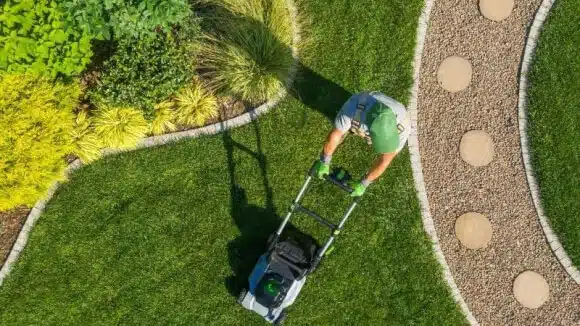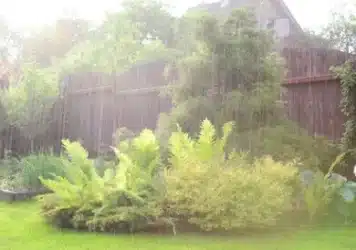How to Apply Landscape Design Principles to Your Garden
Landscape design principles are ideals used to create visually appealing landscapes. Applying landscape design principles can produce a harmonious environment that is both comfortable and aesthetically pleasing. These considerations are great especially when you are revamping a flower garden or shade garden, or prepping an entirely new garden space.
We’ve discussed this concept earlier on the blog (LANDSCAPE DESIGN PRINCIPLES TO INCREASE YOUR HOME VALUE). Today, we review how to apply landscape design principles to your yard and garden for maximum impact. For the purpose of this discussion, we’ll use four landscape design principles: order, proportion, repetition, and unity.
Applying Landscape Design Principles
Order
Order refers to the spatial layout of the landscape. This principle also is referred to as “Balance” since you can achieve order through a proper balance. Balance involves assigning equal value to weight and visual attraction using various colors, forms, textures, and sizes. You get balance by carefully repeating similar features where appropriate.
Designers achieve symmetrical balance by placing similar objects on opposite sides of an axis. They can use similar plants, trees, or flowers on opposite sides of a garden. This approach appeals to the human eye because of the even distribution of items and symmetry.
You can also apply this landscape design principle through asymmetrical balance. Landscapers create asymmetrical balance by assigning equal visual weight to different forms, colors, or textures. This approach can be achieved by placing groupings of trees or garden ornaments of equal visual weight but other characteristics on each side of the axis.
Perspective balance involves balancing the foreground with the middle and background. Designers achieve perspective by using larger objects or brighter colors in the background to balance with the greater visual weight to features in the front of the garden.
Proportion
Landscapers must ensure that the relative proportions of the plants, ornaments, and structures they use are consistent and at human scale. The plants used must be proportionate in relation to the average person, house, or surrounding plants.
Similarly, the amount of open space should be equal to the planted areas. Designers can use proportion to create dominance by contrasting large plants with smaller ones or using similar-sized plants to achieve harmony.
The hardscape should be equally functional and aesthetically pleasing. The tables, benches, gazebos, and pathways should be easy to use and comfortable. Designers should also ensure proportion in open spaces by creating small areas with enclosures. You can apply this landscape design principle on a site such as a patio.
Unity
Landscapers achieve unity by linking design features or elements to create a consistent theme in the composition. They can use different techniques such as dominance or interconnection to create harmony and produce a coherent character. The key to achieving unity is to start with a design style or theme in mind and lay out the landscape to accentuate it.
Unity by dominance is achieved by making a particular shape, plant, or object the focal point of the landscape. The feature captures attention due to its contrast with adjacent items. It can be an ornamental plant that stands out due to its exotic features or a set of bright-colored flowers used to attract hummingbirds or butterflies.
Unity by interconnection involves creating seamless links between features that fit together. Often hardscapes are used for interconnection because they link different spaces in the landscape. You can apply this landscape design principle through fences, stairs, walkways, and paths to physically link areas.
Repetition
Repetition is the use of design elements or features multiple times to create a sequence or pattern. Designers can use a repetitive line, color, texture, or form to produce repetition. You can enhance repetition by employing alternation, where a slight change in the sequence creates a new pattern.
Another form of repetition is inversion, where the next element in the sequence is the opposite of the former. For instance, you could apply this landscape design feature by alternating cone-shaped shrubs with canopies for effect.
A gradation is a form that involves a gradual change in the main characteristic, such as gradually reducing the size of a circular shape.
Repetition can also be in repetitive shapes or colors throughout the landscape instead of discernible patterns. Landscapers must use repetition with care because too much of it can cause monotony.
Do You Need a Professional to Apply Landscape Design Principles?
It may be difficult to apply landscape design principles if you are not a professional landscaper or lack design experience. What’s more, every site has unique challenges that make it hard to apply some themes.
However, you can learn how to use the concepts by observing how landscapers organize other yards, demonstration gardens, and displays.
Suppose you intend to do a large project immediately. In that case, you should consider consulting your local garden center or a landscape design professional to simplify the process around design, maintenance, and care for your yard.
But if you want to try your hand on small patches on your property, do not be afraid to experiment! You can use PlantTAGG to help you make better plant selection choices and planting decisions and help with care guidance on when precisely to water, prune, and fertilize the plants in your new landscape design. Text ‘PLANTS’ to 46376 to get started – PlantTAGG is free to use with nothing to download or install.
If you are a professional landscaper, we’d love to talk with you about the PlantTAGG Landscaper Program. It’s a great way to build your brand, get referrals, and offer a unique value-add to your customers. Get in touch today to find out if you qualify for this incredible new program!













Leave a Reply